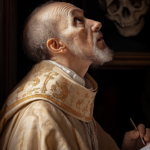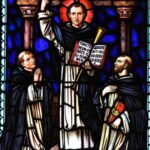St. Ignatius of Antioch
St. Ignatius of Antioch
St. Ignatius of Antioch
When they lived: Approximately 35 AD to 108 AD.
Where they lived: Antioch, ancient Syria.
Notable world events during the time of their life:
- The Great Fire of Rome (64 AD): Devastating fire in Rome during Nero’s reign, blamed on Christians.
- The Jewish-Roman War (66-73 AD): Significant Jewish uprising against the Roman Empire.
- The completion of the Colosseum (80 AD): Iconic amphitheater construction completed in Rome.
- Halley’s Comet appearance (86 AD): Celestial event witnessed with awe and mystery.
- The reign of Emperor Trajan (98-117 AD): Expansion of the Roman Empire and notable public projects.
Patronage: St. Ignatius is the patron saint of Christian unity, theological studies, and those suffering from throat and lung diseases.
Christianity During Ignatius’ Time
We could only imagine how the gospel of Christ had greatly affected the Christians of the first and second centuries. It was like an inextinguishable fire that consumed the heart of every believer. However, the Christian faith had faced tribulations, persecution, mistreatment, and discrimination, and worst of all, the deaths of men, women, children, and the elderly simply because they believed in Christ.
This was the situation during the time of Ignatius. Because he lived a long time ago, little is known about his early life. Almost everything that is known about him comes from the seven letters he wrote after his arrest. Tradition tells us that he was born around the year 50. He was a friend of Polycarp, who later became the Bishop of Smyrna and was martyred for the faith. Polycarp was a disciple of St. John the Evangelist, so it is possible that Ignatius, too, knew the Beloved Disciple.
The Gentle Shepherd of Antioch
At that time, Rome, Alexandria, and Antioch were the three great cities of the Roman Empire. Ignatius succeeded St. John as bishop of Antioch. He was described as a shepherd who was gently leading his flock, a teacher of the Apostles’ doctrines, and an example of putting Christian beliefs into concrete practice.
Ignatius was particularly focused on Christians who thought that they had to follow the Mosaic Law of Judaism. He taught that the old dispensation had been fulfilled in the new. He was a tireless witness to the Word made flesh and countered the Docetists’ teachings that the Word of God made flesh only in appearance and not in reality. Ignatius taught that the Incarnation was the supreme testament of the mercy of God.
An oblation to God
In the year 107, the cruel Roman Emperor Trajan demanded that Ignatius publicly speak out against the faith. The bishop refused to deny Christ and renounce his faith. Enraged by this, the emperor sentenced him to be fed to the lions in the Flavian Amphitheatre. He wanted to give a stern warning to all Christians through this man.
Ten soldiers were appointed to arrest and guard Ignatius on the long trip. He used the time on their journey to write seven letters. These letters were reminders to the members of the church to be steadfast in faith, to be faithful to the Lord, and to obey the teachings of their bishop. These letters also admonished the Christian community to serve and help the poor and needy, their brothers and sisters.
On their way, Ignatius was also met by the local bishops and many members at different places. They all came to honor the holy bishop of Antioch. It is said that Ignatius blessed them and assured them he would pray for all of them.
Ignatius was thrown to the wild lions in the Roman amphitheater. He was not afraid to die. He held fast to the belief that death would be his birth into new life through Christ’s resurrection: “I am writing to all the churches to let it be known that I will gladly die for God if only you do not stand in my way. I plead with you: show me no untimely kindness. Let me be food for the wild beasts, for they are my way to God.” His feast day is October 17.
Five Interesting Facts About St. Ignatius of Antioch
- St. Ignatius of Antioch is the patron saint of the Church in the Eastern Mediterranean and in North Africa.
- As found in his letters, St. Ignatius of Antioch was the first to use the term “Catholic” to describe the whole Church.
- St. Ignatius of Antioch also referred to himself as “Theophorus” or “one that carries God”.
- Tradition says St. Ignatius of Antioch was one of the children Jesus took in His arms and blessed.
- The letters of St. Ignatius of Antioch serve as an example of early Christian theology. Some important topics they address include ecclesiology, the sacraments, and the role of bishops.
Prayer to St. Ignatius of Antioch
Almighty ever-living God, who adorns the sacred body of your Church with the confessions of holy martyrs, grant, we pray, that, just as the glorious passion of Saint Ignatius of Antioch, which we celebrate today, brought him eternal splendor, so it may be for us unending protection. Through our Lord Jesus Christ, your Son, who lives and reigns with you in the unity of the Holy Spirit, one God, for ever and ever



